Anything you can do to stand more or walk more is good! Each of the activities on this page has been done by families of children or adults with Rett syndrome. You can pick from these activities in the home, out of the home at school or the care centre, or in the community.
She uses her stander now in the after school program with the other teens…they hang out and listen to music and she just looks so happy and proud.
Stand more
Stand more at home
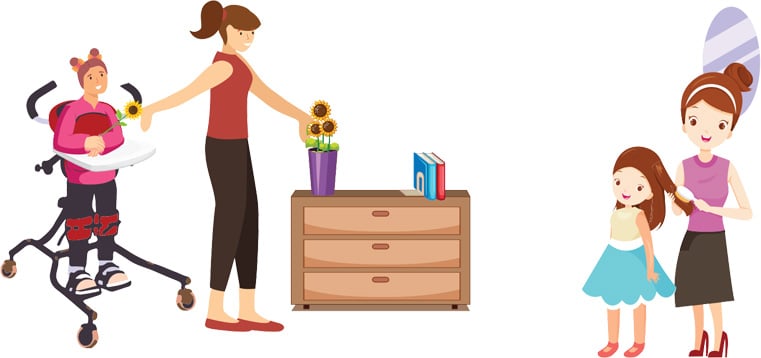
Encourage standing:
- on their own
- with your help or standing at furniture to give support
- using a standing frame - 30 to 90 minutes each day is recommended
Here are some activities that families have used to make standing meaningful.
Standing for indoor play and games, as long as possible - at the kitchen table or a tall table
- Jigsaw puzzles, Lego, bingo, board games, or iPad or computer games
- Hairdresser and dress-up games with siblings
- Use a jelly button to 'score points' during games. The more points, the more rewards (e.g., chocolate) at the end of standing time
- Games using switch-adapted toys (e.g., bubble machine, nerf gun, water gun)
- Play board or dice games using switch-adapted roller dice (e.g., bingo, picture lottery) standing at a tall table
Standing for arts, crafts, music, and hobbies, as long as possible - at the kitchen table or a tall table
- Play musical instruments (e.g., switch-adapted instruments), read a book/magazine, listening to an audiobook, cooking activities
- Do craft activities using adapted equipment (e.g., jewellery maker for pearl bracelets, colour bug, spin art) or use a switch adaptor for sewing machine, while standing at a tall table
- Schedule sit-to-stand breaks (e.g., with music, songs or dance)
Standing for TV, videos, and DVDs, as long as possible
- Standing while watching TV or videos
Standing when getting together with family and friends
- Do activities standing when visiting family members, friends, or fellow residents (if in a group home), e.g., while listening to music, choosing and putting on nail polish, getting a hair makeover
Standing for some household chores or cooking activities
- Participate in household chores
- Fold clean clothes
- Setting up the dining table (e.g., choose napkins)
- Do the dishes in the kitchen sink
- Water plants inside or outside
- Participate in cooking activities
- Use a switch-adaptor for electronic kitchen equipment (e.g., to whip cream, blend a smoothie, prepare dough)
Standing for personal care
- Brush hair while standing to improve movement of upper body and standing endurance
- Dry hair standing, using a switch for hair dryer
- Eat and drink while standing
- Encourage pushing through arms and legs to assist moving from sit to stand
- Stand by bed when getting pyjamas ready at bedtime
Stand more at school/care centre
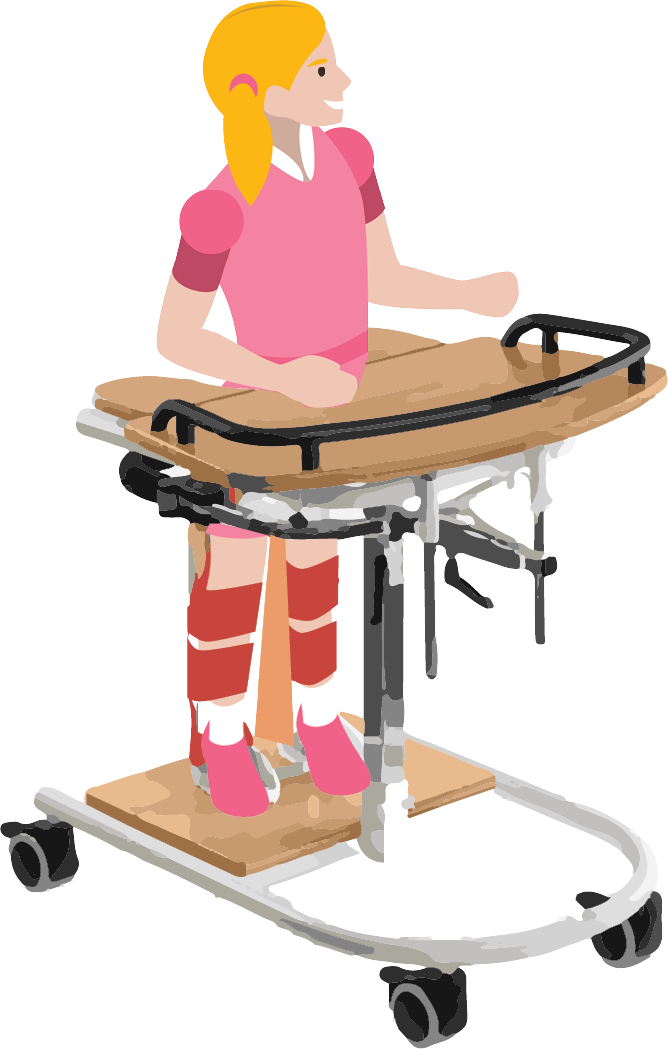
Encourage standing:
- on their own
- with help from you or a support worker or standing at furniture to give support
- using a standing frame - 30 to 90 minutes each day is recommended
Here are some activities that staff at schools and activity centres have used activities to make standing meaningful.
Classroom activities
- Join in classroom games/work activities using a tall table and switch-adapted device
- Cooking classes (e.g. use switch-adaptor for electronic kitchen equipment to whip cream, blend a smoothie, prepare a dough)
- Music classes (e.g. use switch-adapted music instruments)
- Arts and craft classes (e.g. use adapted equipment such as spin art or use a switch adaptor for sewing machine)
- Math classes (e.g. use switch-adapted bingo game)
- Receive assistance to stand to complete fun/functional activities (e.g., chores, dance breaks, complete tasks)
- Give extra opportunities to stand up from chair and have a break from periods of sitting
- Participate in physical education classes using sit-to-stand chair/walker/stander (e.g., use a switch-adapted bowling ramp or tennis ball machine)
Field trips and school events
- Participate in school concerts and choir activities
- Watch sports games/parades/carnivals standing
- Stand during morning assembly
Getting together with peers outside of class
- Stand during eating/drinking breaks
Stand more in community setting

Encourage standing:
- on their own
- with your help or using furniture to give support
Here are some activities to make standing meaningful
Neighbourhood outings
- Bowl using bowling ramp
- Community events
Stand during concert activities
- Stand while watching sports games
She likes to walk around the house, visiting siblings, visiting her bedroom and picking out books to read from the bookshelf.
Walk more
Walk more at home
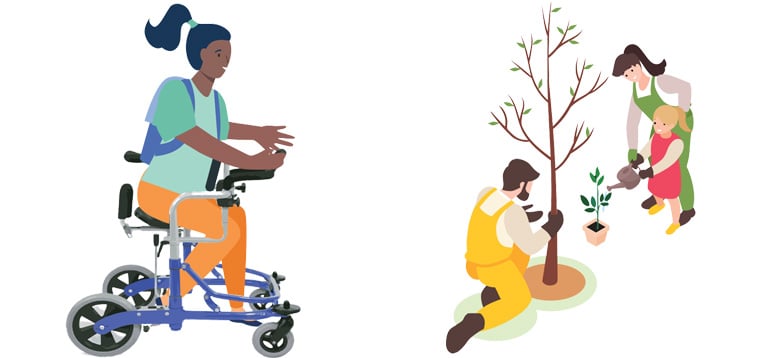
Encourage walking:
- on their own
- with your help or a walking aid
Walking opportunities around the home
- Walk around the house as far as possible between activities (e.g., create walking route inside the house to complete throughout the day)
- Spread chairs/beanbags further apart to incorporate more steps to move between the two points
- Take alternative routes (e.g., from living room to bathroom, around other side of table) to increase number of steps taken
- Regularly walk a lap of the backyard
Play, games, and activities, inside or outside
- Hide-and-seek and scavenger hunt games
- Play in the garden
- Jump on the trampoline
- Kick balls
- Knock down skittles
- Step and dance to favourite music
Arts, crafts, music, and hobbies
- Take movement breaks after prolonged periods of sitting (e.g., a dance break listening to a favourite song or complete puzzles/games)
- Pick flowers from the garden to make a bouquet
- Decorate the house for special occasions
Getting together with family and friends
- Walk to visit friends, others in the house, or fellow residents
Household chores - schedule a routine
- Participate in household chores - allow choices between 2 or 3 different tasks
- Walk to and from mailbox daily
- Help put own clothes into the washing machine
- Help hang clothes on the line to dry
- Set up the dining table
- Load/unload dishwasher
- Take out the bin
- Water plants, inside or outside
- Feed pets
Walk more at school/care centre
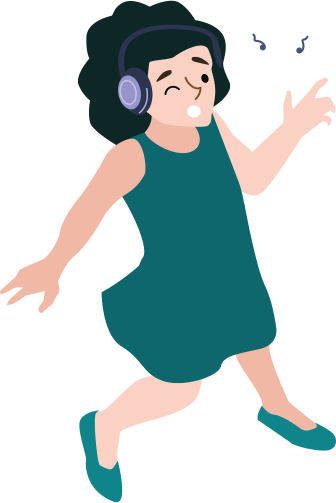
Encourage walking:
- on their own
- with your help or a walking aid
Walking opportunities in the classroom
- Hand out games/activities/worksheets to other students
- Walk between classrooms and between activities (e.g., music class to morning tea) instead of using wheelchair
- Schedule walks in and around school with changing speed (e.g., walk to say hello to other classes or the school office)
- Walk from bus to classroom when going to school, and from classroom to bus when leaving school
- Participate in school chores (e.g., collecting lunch boxes)
- Participate in physical education classes
- Dancing
- Running
- Gymnastics
- Ball games
- Complete classroom obstacle course
- Take regular movement breaks between classroom activities
Getting together with peers outside of class
- Play ball games (e.g., basketball into basketball hoop, kicking ball)
- Participate in games during recess (e.g., hide and seek, four corners, balloon games)
- Have scheduled and timed socialising breaks during classroom activities between students outside while standing
Walk more in community setting
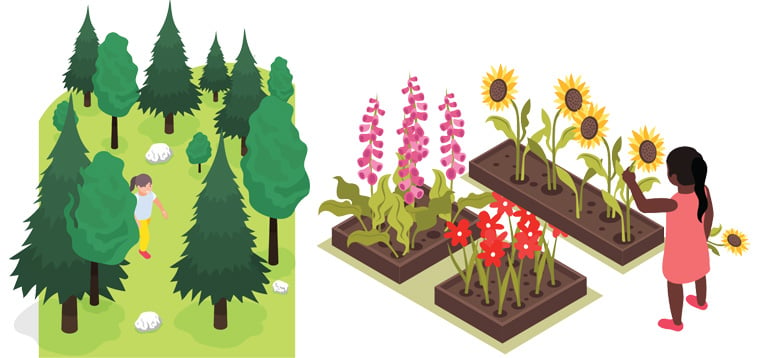
Encourage walking:
- on their own
- with your help or a walking aid
Neighbourhood outings
- Go shopping for personal items or groceries, walking with support from caregivers or trolley as needed
- Scheduled visit to parks and shopping centres
- Ten-pin bowling
- Go to watch a movie and find opportunities to walk inside movie theatre to seat without help
- Visit special locations (e.g., museum, art, gallery, zoo)
- Watch sport games and cheer on local sport teams
Organised physical activities
- Have a weekly or monthly schedule for activities that are enjoyable
- Horse-riding sessions
- Zumba sessions with parent/caregiver
- Gym sessions (e.g., walking on treadmill or riding on bike riding machine)
- Swimming or walking in the water with or without assistance
- Walk in and out of swimming pool on ramp, using railings for support as needed
- Participate in scout team
- Race running
Unstructured physical activities
- Have a weekly or monthly schedule for activities that are enjoyable
- Bicycle riding (e.g., side-by-side bicycle)
- Nature trail walks
- Summer activities
- Swimming at beach
- Surfing
- Canoeing
- Paddle board
- Winter activities
- Skiing
- Sledding
Places for daily walking
- Take the dog for a walk at local park
- Do interval walking - switch between fast walking and usual walking pace (e.g., walk fast for 30 seconds and then usual pace for 30 seconds)
- Visit local playground
- Practice going up and down stairs
- Walk on track in forest
- Help pick herbs and flowers from the garden
- Walk around the park or botanical gardens (pointing out pretty flowers to distract from the prolonged walking)
- Walk on sand at the beach (note: this also works the foot muscles more)
Connecting with community
- Find a volunteer walk buddy and take her out for a walk
- Plant a community garden
- Participate in community fundraising
- Walk-a-thon
- Bake sale
- Family team obstacle course
She was proud of herself when walking in the shops instead of using her wheelchair. I would praise her for doing such a good job, and she was all smiles.




